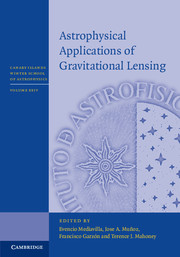Book contents
- Frontmatter
- Contents
- List of contributors
- List of participants
- Preface
- Acknowledgements
- 1 Lensing basics
- 2 Exoplanet microlensing
- 3 Four case studies of microlensing
- 4 Gravitational (micro)lensing of quasars and AGN
- 5 Dark matter in clusters and large-scale structure
- 6 The future of strong lensing
- 7 Methods for strong lens modelling
- 8 Tutorial on inverse ray shooting
- References
7 - Methods for strong lens modelling
Published online by Cambridge University Press: 05 September 2016
- Frontmatter
- Contents
- List of contributors
- List of participants
- Preface
- Acknowledgements
- 1 Lensing basics
- 2 Exoplanet microlensing
- 3 Four case studies of microlensing
- 4 Gravitational (micro)lensing of quasars and AGN
- 5 Dark matter in clusters and large-scale structure
- 6 The future of strong lensing
- 7 Methods for strong lens modelling
- 8 Tutorial on inverse ray shooting
- References
Summary
This chapter discusses computational and statistical methods for fitting models to strong lens data. It centres on parametric models of point-like lenses but includes extensions to composite models, free-form models, and extended sources. It describes how to use statistical tools including Monte Carlo Markov chains and nested sampling to explore the range of models that are consistent with data.
Introduction
Strong lensing is a versatile tool for astrophysics that can be used to study the physical properties and environments of lensing galaxies, to dissect the structure of source quasars and galaxies, to constrain cosmological parameters, and much more. Other chapters in this volume review the theory of strong lensing, the status of observations, and the variety of astrophysical applications that result. The goal of this chapter is to outline methods for fitting models to strong lens data. Since modelling is required for most applications of strong lensing, understanding the strengths and weaknesses of the analysis is key for drawing robust conclusions.
When discussing methodology, we need to distinguish between point-like and extended images. Point-like images (in a lensed quasar, for example) provide constraints on the potential and its derivatives at discrete positions, which can be described with a modest number of constraint equations or a straightforward χ2 goodness of fit statistic. Established statistical methods can then be used to find the best fit and explore the range of allowed models. In this case the barrier to entry is low in the sense that fitting basic models does not require tremendous expertise, yet the potential for growth is high in the sense that advanced analyses can combine lensing with other astrophysical probes to draw conclusions that have broad reach. Extended images, by contrast, provide many more pixels of data but require many more free parameters (associated with the unknown shape of the source). Specialized methods must be used to simultaneously fit a mass model for the lens and a light model for the source. For pedagogical purposes, I focus on analysis methods that are applicable to point-like sources but include an overview of methods for modelling extended images (Section 7.5.4).
- Type
- Chapter
- Information
- Astrophysical Applications of Gravitational Lensing , pp. 213 - 250Publisher: Cambridge University PressPrint publication year: 2016



